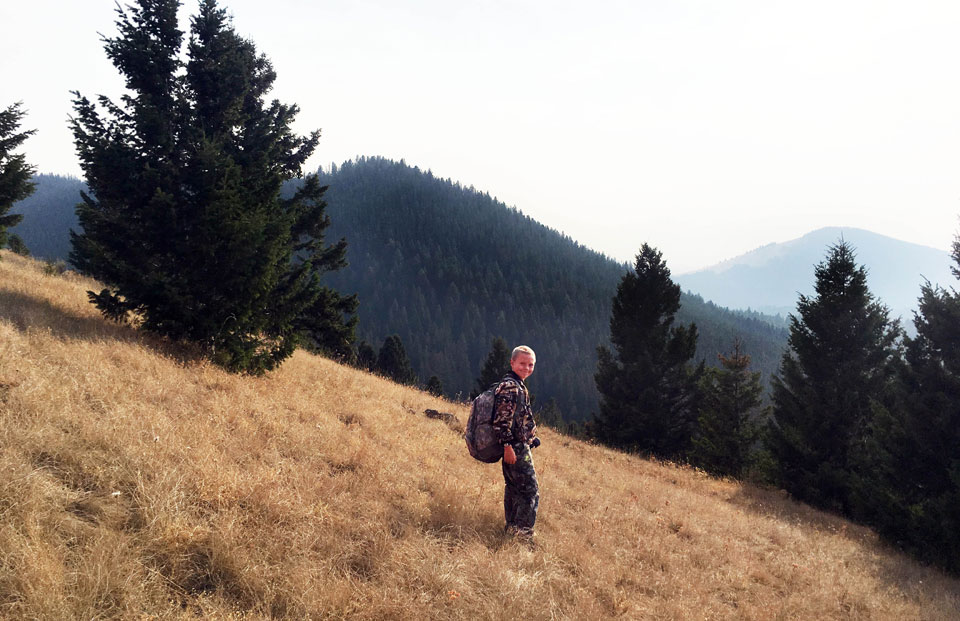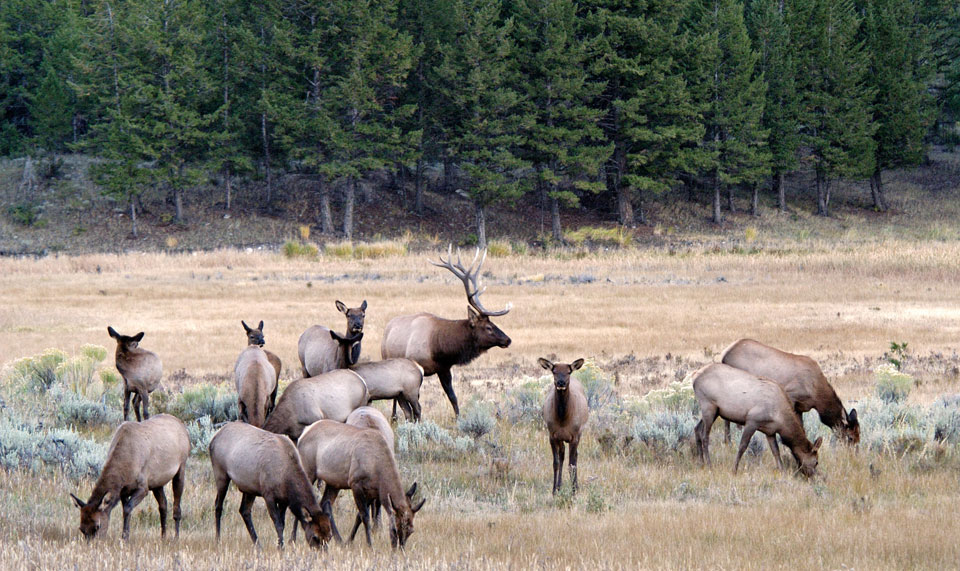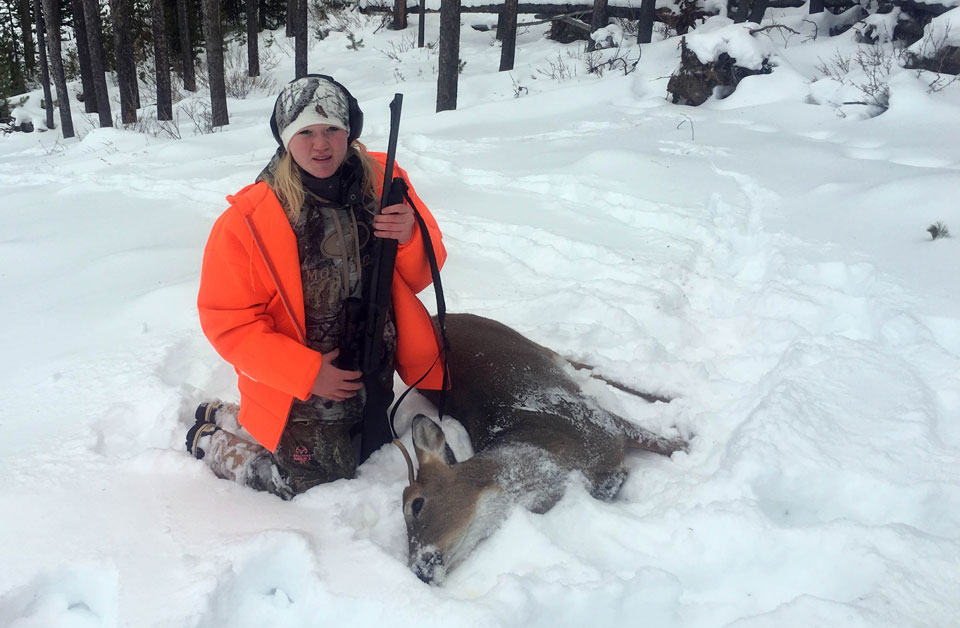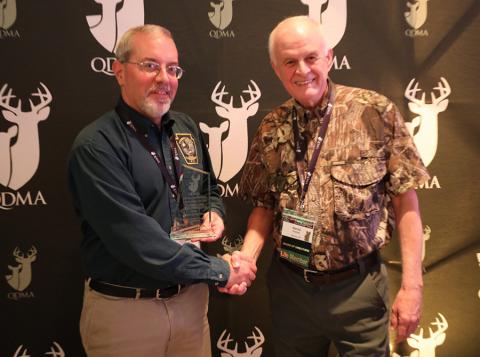Mossy Oak ProStaffer Paul Henze of Deer Lodge, Montana, started hunting elk in 2005. He drove from his home in Wisconsin every other year to hunt in Montana, until he moved to there in 2015. Primarily a bowhunter, Henze didn’t start hunting with a rifle until 2017.
Hunting is a Family Endeavor

I started hunting elk with a gun in 2017, since I wasn’t able to guide my daughter Tiffany, who’s 22 years old, to a bow elk. We thought she might have a better chance with a rifle. So last year, we both hunted with rifles. Tiffany loves to hunt elk. My daughter Crystal is 17, and my daughter Holly is more of a girlie girl and doesn’t like to hunt. My youngest is Chace, my 10-year-old son, who is my shadow. Every time I go elk hunting, he thinks he should go too. In 2017, Chace and I hunted together for elk for two weeks with some other friends of mine.
Last year, Crystal, Chace and I chased an entire herd of elk. Chace is just learning to call elk, and he’s pretty good. So, I put Crystal in front of the two of us, I was over on the right corner, behind Crystal, and I put Chace behind Crystal over in the left corner. Chace and I began calling, when suddenly Chace didn’t wait for me to call. He just started and kept on calling. Chace was supposed to look at me, and I’d give him the signal to call or not call. Before long, we had elk all around us. Crystal had a big cow elk in front of her stand at 12 feet. However, Crystal didn’t feel comfortable with her shot, so she let the big cow elk walk. She shoots a Diamond Infinite Edge bow. If she had a gun, she easily could have taken the shot. But she loves to bow hunt.
I’ve been taking Crystal elk hunting, since she was 12 years old. She started out hunting whitetails with me, but once she got to go elk hunting, she fell in love with hearing the bulls bugle right in her face. The hair on the back of her neck would stand up. She decided that she only wanted to hunt elk. When I asked her why she didn’t squeeze the trigger on her mechanical release and take the cow elk, she answered, “There’s always a next time.”
Chace was upset and asked his big sister, “Why didn’t you shoot?” Crystal answered that she didn’t have a shot. Then those two started arguing about why we didn’t have an elk to drag out.
We work closely with the Rocky Mountain Elk Foundation (RMEF). In 2017, Chace and I were on the committee for the elk banquet. The chairman of the committee came up to Chace and said, “Do you feel comfortable enough about your elk calling that you could go up on the stage and call in front of everyone attending the elk banquet?”
“Yeah, I can do that,” Chace said with a smile.
There were 425 people who attended the RMEF banquet last year. Chace got up in front of them and made three calls. Everyone at the banquet cheered him on and clapped. I was very proud of Chace and decided that he really could call better than I thought he could.
First Bull Elk in Colorado
In 2012, I took my first bull elk and harvested him with my bow. That year I was hunting in Colorado, right outside of Steamboat Springs. I had two 5x5s, a spike and two cows that came to me, not making any sounds. I was leaning against a Ponderosa pine and heard a twig snap behind me. The elk were only about 45 yards from me when I saw them. I had my PSE DNA bow with me with a Thunderhead broadhead on each of my arrows. When they were that close, I went ahead and drew my bow. One of the cows spotted me. The bull closest to me stopped, and I remembered the mantra of, “Don’t pass up a bull you would take on the last day.” This bull closest to me was a small 5x5, but he was my first bull I’d taken with a bow. He ran about 45 yards after I shot, and I watched him tip over. The excitement only lasted for a few minutes, and then I thought, “Now the work begins.”
I was about three-quarters of a mile off the road, and I realized I’d left my frame pack in my truck. I did have my game bags with me in my daypack. So, I went ahead, skinned the elk out, quartered him, loaded the tenderloins into my back pack, returned to my truck and got my frame pack with all my cutting tools. I wanted to bone out the elk with my knives, so I wouldn’t have to make as many trips or carry as much weight as I would if I quartered him only and had to carry that meat out. I’d shot the elk at about 4 p.m., and by the time I deboned the meat and made four trips in and out, I got back to my camper about midnight.
My wife absolutely loves elk meat, and she enjoys preparing and eating elk. She’s not much on venison. Every time I hunt elk, she says when I leave, “You’d better bring an elk home this time.”
For great elk recipes, check out the free ebook “Miz Denise’s Outdoor Cooking: More Than 35 Recipes for Elk and Mule Deer.”
A Big Miss Rifle Hunting Elk

I had four of my buddies from Wisconsin come to South Dakota last year to elk hunt with me. I was mainly planning to guide for them and help them try to take elk. I had my daughter Crystal and son Chace with me. Although everyone had a bull elk shot opportunity, no one took an elk.
We had hiked in for some time, and then we sat down to take a break. “There’s elk over on that other mountain,” Chace told me while I was talking to my hunting buddies. We put those elk on the mountain to bed that night and determined we’d come back and hunt them the next morning. However, when we returned, that herd of elk had moved off public land onto private land. I was grumpy. One of my friends, Aaron Underwood, turned around, looked behind us to see out in a meadow and asked, “Is that elk out there?” The elk were above us, and suddenly they started coming down a trail right to us.
We had leaned all our guns up against a pine tree about 10 feet from where we were sitting. So, we all hurried over to that pine tree to retrieve our guns. Cow elk started coming right past us at about 20 yards, and then elk came up the mountain behind us. Aaron sighted in on a bull moving up behind us, and I saw a bull coming down the hill in front of us.
“I’m shooting,” I told Aaron.
So, I shot and missed my bull, and Aaron missed the bull coming to him. I thought that Aaron had hit his bull, but I knew for certain I’d missed my bull. I wanted to go down and see if we could find Aaron’s bull. But we discovered no blood – just the bull’s tracks in the snow. After following the tracks for some way but never locating any blood, we returned to where the other hunters were waiting. We both felt lower than snakes’ bellies. I’d missed because I had miscalculated how far away the elk were. When I ranged the spot to where the elk had been standing, I assumed before I took the shot that the elk were 200 feet from me. But when I ranged the spot the next morning, I realized the elk were actually 400 yards from me. Of course, when we returned to camp, we took a wagon load of harassment from all our hunting buddies. We both had had good shots at bull elk, and we both missed. Glassing western terrain /our-obsession/blogs/hunting/leupold-optics-tips-for-hunting-elk can be difficult.
At the end of the week, Aaron and my other buddies had to return to Wisconsin to work. I had to send Chase and Crystal back to go to school. I’m a heavy-equipment operator, and I was laid off during elk season. Our area of Montana started getting snow in September, and the falling snow never seemed to stop the rest of the year.
When Chace left for school on that Monday, I got in my truck, drove up to public land and started hiking in the thigh-high snow. I didn’t have snow shoes last year, but I promise you I’ll have snow shoes this year. I came to a spot and took a break from my hike. I still was aggravated about missing the bull the week before. My wife also was grumpy because I didn’t bring home any elk meat. She told me, “You go out hunting all the time, and you’re not bringing any elk home. You’ve got to do better.”
I’d sat down to rest, but when I got cold, I stood up, looked around and spotted two, 5x5 bulls running up the mountain toward me. I grabbed my rifle, and when the first elk was within range, I shot him. That elk took off running, and I quickly reloaded and put another round into him. He went over a ridge. I sat back down to wait before going after the bull. Suddenly the other 5x5 bull came up by himself. After that bull was out of sight, I decided to go and find my elk. But before I could look for my bull, I spotted a herd of elk coming toward me – probably 30-40 elk. A huge herd bull was right in the middle of all those other elk. I thought, “If I hadn’t shot that 5x5, I could take that trophy bull.” However, I remembered I had what was called a shoulder season tag, a bonus cow tag. That tag only was good on state land or on private land that the Montana Fish, Wildlife & Parks had an agreement with a landowner to let the public hunt on his land.
I sighted in on a cow and heard a little voice inside of me say, “You already have a bull down, do you really want to shoot a cow, and have two elk to cut up and then pack back to the truck in thigh-high snow by yourself?” So, I let that herd pass me, without taking that cow I could have harvested. Luckily, reason overcame my excitement about the possibility of taking a second elk that day.
Once the elk had gone, I went over the small knoll and located my 5x5 bull. He’d only gone about 50 yards from where I’d shot him. As with my first bull, I’d left my frame pack back at my truck. I went ahead and field dressed and quartered my bull, returned the 1/2-mile to the truck, got my frame pack and didn’t debone the elk but instead made several trips to carry out all the meat.
After I made the first trip out with my elk on my back, the wind was blowing, the snow was still coming down, and the trail I’d taken in was covered with snow. I had to cut a new trail to keep returning to my elk to get it out. I fell down three times trying to carry that elk out, but thank goodness, there was snow to break my fall. I shot the elk about 10 a.m., and I finally got all the meat out to my truck by 3 p.m.
Deer for the Daughters

I started taking my oldest daughter hunting as soon as she wanted to go, and she’s taken a few whitetails but no elk yet. Crystal shot her first whitetail in 2017. She didn’t think she’d be able to shoot an animal, so I told her that that was okay. Hunting whitetails or elk is all about the hunt and seeing the animals.
“If you don’t want to shoot, you don’t have to shoot,” I told Crystal. “You don’t have to shoot something to enjoy a great hunt. Each hunt is a learning experience and an opportunity to get out in nature and have fun pursuing the animals, whether or not you take one.”
I took Crystal to a spot where I’d taken an elk before, because I knew the land very well. Crystal had an elk tag and a deer tag. She was so excited about going with me that she forgot to put on her base layer of clothing.
“Okay,” I told her. “We’ll return to the truck and eat some breakfast, you can get warm in the truck, and we’ll return to camp where you can put on your base layer. Then we’ll go hunting again.”
On the way back to town, we were in deep snow, and I was pushing snow – probably three feet deep - with the front of my truck. I spotted a spike white-tailed deer on the side of the road that went up the mountain in front of us.
I told Crystal, “There’s a white-tailed buck.”
Crystal asked excitedly, “Can I go after him? Can I shoot him?”
I pulled my truck off to the side of the road and we both got out on my side of the truck and stayed low enough to keep the buck from seeing us. We worked our way up the mountain to reach the same height where the buck was. Crystal had forgotten all about being cold.
In Montana, a white-tailed buck must have four inches of antler above the hairline to be legal. I used my binoculars to check out the buck and said to Crystal, “He’s legal.” Instantly Crystal mounted the 7mm-08 and fired. I still was looking through the binoculars when Crystal fired, and I wasn’t thinking she’d shoot. I jumped when the rifle fired.
Once we reached the buck I tried to encourage Crystal to learn how to field dress the deer. I always do that with my children. However, Crystal didn’t want to field dress the buck. I asked her to keep the deer’s legs open, so I could field dress him. Then Crystal and I started dragging the buck out. Due to so much snow being on the ground, and our dragging that buck downhill, this drag became the easiest ever.
When my oldest daughter, Tiffany, took her first white-tailed buck in Wisconsin, the buck had a nice rack. We were hunting on 80 acres of family land, and she was so excited that the first whitetail she took was a nice buck. I had it mounted, and she took the buck with her to New York where she’s going to college. I don’t know who was more excited when Tiffany took that buck. We were in a two-man ladder stand, and it was so cold that morning that we had a blanket covering both of us.
We spotted three white-tailed bucks coming down a hill toward our stand. The first buck was a spike, the second buck was a 3x3, and the third buck was an 8-pointer. As the deer drew closer to us, I said, “Tiffany, you can shoot whichever buck you want to shoot. You pick out the one you want.”
She was only 12 years old at that time. When the spike came past us, I told her, “You can shoot it.” But she told me another was coming. When the 3x3 was within range, I said, “Shoot it, Tiffany. That’s a nice buck.” Again, she told me, “Nope, there’s another one behind it.” Once the 8-pointer stepped out, I said, “Shoot, shoot him.” She answered, “No, Dad, I’ve got to wait for a clean shot.” When Tiffany had a clear shot, she squeezed the trigger, and the buck went down right where he’d been standing.
I was screaming, “Yeah, way to go, Tiffany,” and she was embarrassed that her dad made such a big deal out of her killing a deer. She was excited, but I don’t think she was as excited as I was for her! The next year, Tiffany took a big doe, and the following year, she took another doe that was wounded on the property adjoining our land. We have a rule on the family land we hunt that any deer that comes across the property line that has been wounded, we finish it off – whether it’s a buck or a doe.
Join in Elk Hunting and Conservation
When I still lived in Wisconsin and was elk hunting in Montana every other year, my family started working Rocky Mountain Elk Foundation (RMEF) banquets for Mossy Oak. Once we finally moved out here to Montana, I decided I needed to give back more to the wildlife and conservation organizations that protected and perpetuated the wildlife we had to hunt, so I got Chace and myself more involved in the RMEF here in Montana.
I know some people may balk at having to pay $1,000 for an elk and a deer tag. However, if you go to Colorado and buy a $600 elk tag and a $300 deer tag, you’ve almost spent as much as hunting Montana costs. Our mule deer tags in Montana are on a draw basis, so you must go into the lottery to try to get a mule deer tag, however, 90 percent of the people in the lottery will draw a mule deer tag. Then you can get a whitetail and a mule deer tag. Although most people come to Montana to hunt mule deer, we’ve got some awesome whitetails. I do all I can to get people to come to Montana to see what we have available out here. I try to take new hunters every year. I want the hunters to see that a mountain hunt for mule deer or elk is far more than just harvesting a mule deer or an elk. It’s about the experience. Taking an animal is just a bonus.
One of the reasons I’m fairly successful when I’m hunting for myself or taking first-timers out elk hunting is because I put out trail cameras during the summer months, long before elk season starts, setting them up over wallows. Then I can judge about how many cows and bulls are coming in to the wallows. I’ve got a game camera set-up that’s on the bench of a mountain, some ways from my house. Several different wallows are near it. The first year I was out here, I hung my game camera over one of those wallows. I went back two weeks later and pulled my card out of the camera. I noticed my game camera was crooked on the side of a tree. I thought perhaps a bear had gotten hold of my game camera. When I looked at the card, I spotted a couple of 5x5 bulls and a 6x5 bull. Then I started getting pictures of eyeballs, and the camera was bouncing off of something that made all my pictures white. As I looked through the card, I saw elk coming over and beating up my cameras with their antlers and their heads.
I hunt the Beaverhead-Deerlodge National Forest that’s so close to my home that if the snow’s not too bad, I can get to my hunting spot in 15 minutes. Up until last year, not very many people hunted where I was. But last year, our area had a number of forest fires around the Missoula, Kalispell and Whitefish regions, so I think many of the elk hunters who usually hunted up there came down to Deerlodge to hunt. That’s fine, because it’s a national forest where anyone can hunt. I have an advantage, too, that these hunters don’t know the land here like I do. If you’ve never been to Montana elk, mule deer or whitetail hunting, you certainly need to plan a hunt out here. Seeing this vast country and all the elk, the deer and the other critters that live out here is well worth the trip. If you’re a first-timer, I’ll try to give you some suggestions about where you may want to hunt. I know your coming to Montana will be well worth the money, the time and the effort to look for a bull or a cow elk, mule deer or whitetail deer here in Montana.



























